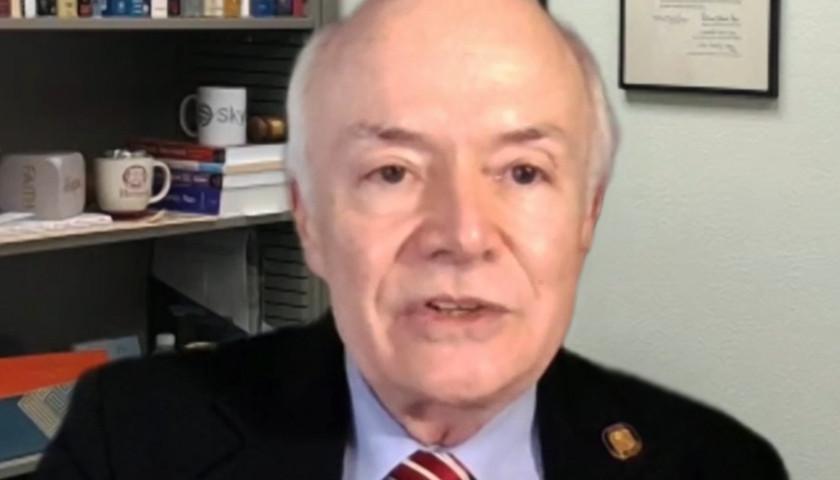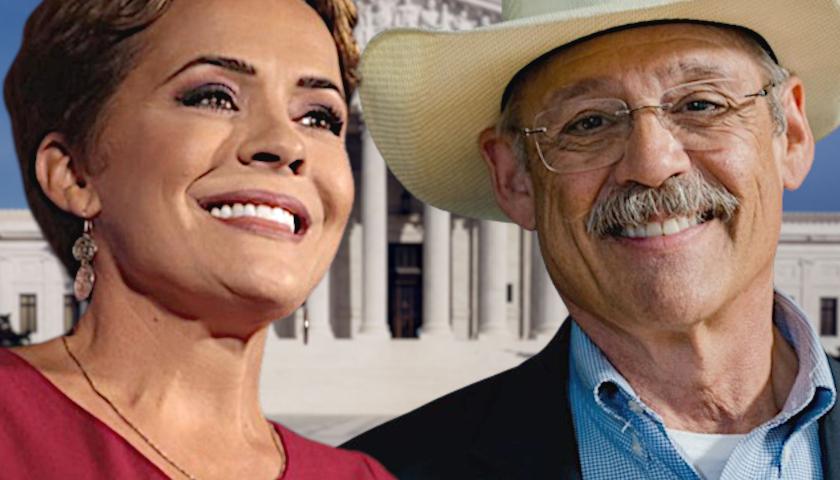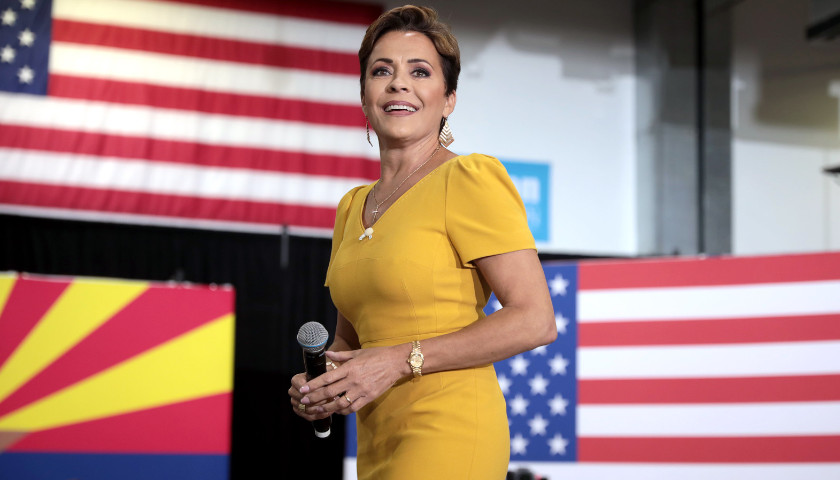Attorneys for Kari Lake and Mark Finchem filed additional pleadings last week with their Petition for Certiorari at the U.S. Supreme Court, providing new evidence to their plea to the court to reconsider the lower courts’ rulings against their lawsuit to stop the use of voting machine tabulators. The new filings include a Motion to Expedite and declarations from top cybersecurity experts, who provided evidence that “overwhelmingly demonstrates” that the election results in 2020 and 2022 from Maricopa County contained “artificial control over the tabulation of ballots and the election results for the November 2020 election.” Additionally, they asserted that the county thwarted efforts to obtain the new data, which is a crime punishable by up to a year of incarceration.
The appendix to the Petitioners’ Motion to Expedite included 176 pages of new affidavits from Clay Parikh, Benjamin Cotton, and Walter Daugherity. Daugherity (pictured here), who taught computer science and engineering at both the undergraduate and graduate levels for 37 years and served as a computer consultant to major firms and government agencies, including classified work, said this was his second declaration filed in the case, based on the new information from Maricopa County. That information included system log files from Maricopa County’s electronic voting tabulators in the 2020 election, and according to Parikh, “a copy of Maricopa County’s election systems database and the forensic images of the vote center tabulator memory cards used in the 2020 General Election.”

Daugherity asserted, “The evidence overwhelmingly demonstrates to a reasonable degree of scientific and mathematical certainty that the sequence of the Cast Vote Record (‘CVR’) data in both Maricopa County, Arizona, and Pima County, Arizona, shows artificial control over the tabulation of ballots and the election results for the November 2020 election.” The CVR is an electronic representation of how voters voted.
He said it could have been “implemented by manual means or by a computer algorithm.” However, due to the complexities, “requir[ing] a prohibitive amount of calculation to accomplish by hand,” he said “some type of computer algorithm is indicated.”
Daugherity went into further detail about the machines, “This same type of manipulation occurred both in Pima County, Arizona, which used ES&S voting machines (as did most other counties in Arizona), and also in Maricopa County, Arizona, which used Dominion voting machines (as did 23 other states), indicating that the same (or similar) software was responsible.”
Daugherity laid out how Maricopa County thwarted attempts to look at the CVR. He obtained the CVR from the 2020 election through public records requests, but when he asked for the 2022 CVR, “the county refused, and only released a redacted CVR with all rows randomly shuffled, thereby destroying the sequence information as to the order the batches of ballots were tabulated.”
Since “it is impossible to detect controlled manipulation,” Daugherity asserted that “Maricopa County thus deliberately blocked the ability to determine whether the processing of ballots in the November 2022 election was manipulated as I had concluded in my First Declaration with respect to the November 2020 election.” He suggested a remedy, “Should the Court be able to obtain from Maricopa County the original unredacted unshuffled CVR for the November 2022 election, I stand ready to analyze it for controlled manipulation in the same way as I did the 2020 CVR.”
Daugherity pointed out that the county may have violated federal law, since “deliberately concealing and/or altering the sequence information of the public election record may violate 52 U.S.C. § 20702 (codified from § 301 of the Civil Rights Act of 1960), which prescribes penalties for concealing or altering an election record.”
Cotton, who has over 27 years in computer forensics, including over 20 years as an instructor of computer forensics and incident response, revealed how the software was not certified, allowing easier manipulation. “The tabulator logs from the Maricopa County 2020 and 2022 elections demonstrate clearly that the machine behavior settings (MBS) and the database versions that existed on the tabulators used in those elections were not approved by the EAC [Election Assistance Commission] certification of Dominion Voting System (DVS) Democracy Suite version 5.5B,” he said.
Cotton said the security key for the software was stored in plain text where it was easily accessible, “This egregious security lapse provides anyone with access to the voting system with the tools to alter election results without likely detection.”
He went on, “The Maricopa EMS has a compiler installed that provides the ability to modify and create executable files and drivers on the fly that could be used to alter election results without detection. There is evidence new executable files were created at least three times during the active voting period in 2020.”
He said the government’s official audits failed to find material changes that were made. “EAC authorized voting system auditors Pro V&V and SLI Compliance failed to detect material changes to the voting systems in their audits of February 2021.”
Parikh, whose background includes certificates as Certified Ethical Hacker (CEH) and Certified Hacking Forensic Investigator (CHFI), and cybersecurity work for the Department of Defense and NATO, said he had submitted four declarations in Lake’s election challenges, and after the last one, received new evidence leading to the fifth affidavit.
He found that “Maricopa used election software cobbled together with components from 3 No. 23-1021 3a versions of Democracy Suite 5.5B and 5.10. Democracy Suite 5.10 is not approved for use in Arizona by the Secretary of State or by the EAC in any capacity.” The county testified that it did not install “antivirus and operating system security patches” since they contended it would “violate the official certification.”
Parikh went into further detail. “One of the components that has been grafted onto Maricopa’s election software is the Machine Behavioral Settings (MBS) of California’s Democracy Suite 5.10, to include the election counting rules which govern how ballots are read and votes are tabulated,” he said. The SLI Compliance audit report “either did not assess the same election software as that used in the 2020 General Election or falsely claimed that they had.”
Parikh said the uncertified software was again used in the 2022 election. He also cited the county’s failure to conduct Logic & Accuracy testing as required by law on the voting machine tabulators that were used in the 2022 election, and placing the secret encryption key to access the software “in plaintext, unprotected within the election database.”
The Motion to Expedite, filed by attorneys Kurt Olsen, Lawrence Joseph, and Patrick McSweeney, said the newly discovered evidence creates an urgency for the court to address it before the 2020 election. It emphasized, “Maricopa not only violated mandatory election-integrity measures under Arizona election law but also misled the district court to believe Maricopa complied with those measures.”
The U.S. Supreme Court “receives approximately 7,000-8,000 petitions for a writ of certiorari each Term,” but “grants and hears oral argument in about 80 cases.”
– – –
Rachel Alexander is a reporter at The Arizona Sun Times and The Star News Network. Follow Rachel on X / Twitter. Email tips to [email protected].
Photo “Kari Lake” by Kari Lake; Photo “Mark Finchem” by Mark Finchem; Photo “U.S. Supreme Court Building” by U.S. Supreme Court.





